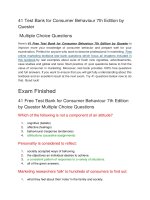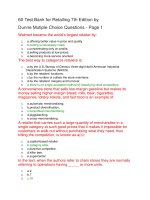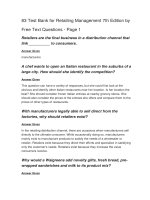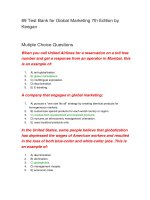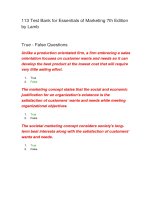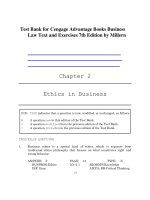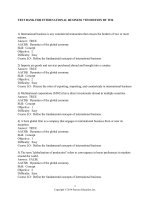41 test bank with answers for consumer behaviour 7th edition by quester
Bạn đang xem bản rút gọn của tài liệu. Xem và tải ngay bản đầy đủ của tài liệu tại đây (50.29 KB, 9 trang )
41 Test Bank for Consumer Behaviour 7th Edition by
Quester
Multiple Choice Questions
Here’s 41 Free Test Bank for Consumer Behaviour 7th Edition by Quester to
improve more your knowledge of consumer behavior and prepare well for your
examination. Perfect for anyone who want to become professional in marketing. Free
online marketing textbook test bank questions which focus all chapters included in
this textbook by real examples about suite of fresh new vignettes, advertisements,
case studies and global and local. Start practice 41 quiz questions below to find the
value of consumer in marketing. Moreover, test bank provides 100% free questions
and full answers. If you want to ensure that you will get fully understanding about this
textbook and an excellent result at the next exam. Try 41 questions below now to do
that. Good luck!
Exam Finished
41 Free Test Bank for Consumer Behaviour 7th Edition
by Quester Multiple Choice Questions
Which of the following is not a component of an attitude?
1.
2.
3.
4.
cognitive (beliefs)
affective (feelings)
behavioural (response tendencies)
attributions (causative assignments)
Personality is considered to reflect:
1.
2.
3.
4.
socially accepted ways of behaving.
the objectives an individual desires to achieve.
a consistent pattern of responses to a variety of situations.
all of the given answers.
Marketing researchers 'talk' to hundreds of consumers to find out:
1.
2.
3.
4.
what they feel about their 'roles' in the family and society.
how they use various products.
their hopes and dreams for themselves and their families.
all of the given answers.
The consumer decision-making process begins with:
1.
2.
3.
marketing efforts.
the recognition of a difference between an existing and a desired state.
the alternatives available.
4.
none of the given answers.
Injurious consumption is:
1.
2.
3.
4.
the way an individual behaves in a group.
consumer behaviour that may be harmful to oneself.
consumer behaviour that may be harmful to others.
all of the given answers.
Customer value is:
1.
2.
3.
4.
5.
6.
derived from the price of the product.
the difference between all of the benefits derived from the total product and all
of the costs of acquiring those
products.
the cost to the consumer of altering their behaviour to buy a product.
the difference between the perceived financial and social costs in obtaining
the product and the financial and
social gain in owning the product.
Which is not an element of the marketing mix?
1.
2.
3.
4.
product
people
place
price
Consumer behaviour theory provides the manager with:
1.
2.
3.
4.
more problems than it solves.
concrete solutions to most marketing problems.
the proper questions to ask in specific market decision situations.
none of the given answers.
All of the following relate to culture except:
1.
2.
3.
4.
values.
beliefs.
basic physiological motives.
habits.
Attitudes represent:
1.
2.
3.
4.
a basic orientation for or against some object.
non-factual as opposed to factual information.
emotional as opposed to rational evaluations.
Page 6 of 8subjective as opposed to objective feelings.
Consumer lifestyle includes:
1.
2.
a focus on luxury goods.
good and services we buy.
3.
4.
rejection of materialism.
none of the given answers.
The household:
1.
2.
3.
has a regular life cycle.
has a predictable life cycle.
can be used to develop aggregate pictures of the purchase needs of
individuals at each stage.
4. All of the given answers are correct.
Positioning:
1.
2.
3.
4.
can be based only on real product advantages.
is the same as repositioning.
is the way a product compares to its competitors, as perceived by consumers.
is generally limited to observable behaviour.
Which of the following often leads to lifestyle changes?
1.
2.
3.
4.
the results of past consumption decisions
time-related events such as ageing
external events such as a job change
Page 4 of 8 all of the given answers
The consumer behaviour audit is a:
1.
2.
3.
4.
review of marketing recommendations.
checklist to evaluate marketing strategies.
systematic review of all important aspects of consumer behaviour.
checklist to evaluate marketing strategies and systematic review of all
important aspects of consumer
5. behaviour.
Modernism is based on:
1.
2.
3.
4.
reason and a rational order.
autonomous investigators and subjects.
the existence of a single objective reality.
all of the given answers.
Global marketing is:
1.
2.
3.
4.
5.
6.
rapidly sweeping the world and leading to the largest period of sustained
global economic growth ever
experienced.
the cause of consumerism.
a form of international marketing that aims to target particular consumer
segments using a standardised
marketing mix.
necessary for any company to understand consumer behaviour.
The post-purchase process involves:
1.
2.
3.
4.
consumer redress.
consumer satisfaction.
product safety.
all of the given answers.
Which of the following is not an example of internal influences in the
consumer behaviour audit?
1.
2.
3.
4.
Is the product suited for particular personality types?
Who in the household evaluates the price of the product?
What is the ideal version of this product in each market segment?
Will price be perceived as an indicator of status?
Benefit segmentation:
1.
2.
is useful only for business-to-business products.
involves a focus on the particular outcome consumers seek from using a
product.
3. involves a focus on emotional appeals.
4. is useful only for consumer products.
To be successful, a new product:
1.
2.
3.
4.
must be a true innovation.
must be priced higher than competing products when first introduced.
must be priced lower than competing products when first introduced.
must solve a consumer problem.
Postmodernists believe all of the following except:
1.
2.
3.
that all reality is constructed by the individual or group.
that knowledge is independent of time.
that all reality is determined by an individual or group even more than by
objective reality.
4. that there are multiple realities.
Which is the following is not one of the major questions related to
social class?
1.
2.
3.
4.
On what characteristics is the social structure is built?
What degree of consumerism is there in a given society?
To what extent do various societies structure and rank individuals?
In what ways does the social structure influence consumer lifestyle?
Consumerism and consumer behaviour deals with:
1.
2.
3.
the study of consumer behaviour and socialism.
consumer protection and governmental regulation of marketing.
non-profit consumer marketing.
4.
none of the given answers.
Motives are:
1.
2.
3.
4.
forces that initiate and direct consumer behaviour.
physiologically based guides to behaviour.
psychologically based patterns of behaviour.
future based responses to current stimuli.
Social class:
1.
2.
3.
4.
is unrelated to consumer lifestyle.
relates only to purchase of durable goods.
does not relate to values and attitudes.
relates to ranking of individuals.
The marketing manager should view the consumer as:
1.
2.
3.
4.
a decision-making unit.
a problem solver.
being primarily concerned with economic factors.
automatically responding in set ways to marketing stimuli.
Consumer behaviour draws on many disciplines, such as:
1.
2.
3.
4.
clinical psychology.
experimental psychology.
sociology.
all of the given answers.
Consumer behaviour is:
1.
2.
3.
4.
a complex, multidimensional process.
easily understood by marketing managers.
a complex, unidimensional process.
none of the given answers.
Post-purchase process includes:
1.
2.
3.
4.
use.
disposal.
repurchase behaviour.
all of the given answers.
A group is made up of:
1.
2.
people who tend to know each other.
two or more people who have a purpose for interacting over some extended
period of time.
3. two or more people who occupy the same space in any one moment.
4. all of the given answers.
The product section of the consumer behaviour audit covers which
of the following influences?
1.
2.
3.
4.
external
internal
decision-process
all of the given answers.
In low-involvement purchase decisions:
1.
2.
3.
4.
there is simple evaluation of performance.
substitution is less likely.
many performance criteria are used.
All of the given answers are correct.
Postmodernists tend to view knowledge as being dependent on all
of the following except:
1.
2.
3.
4.
time.
culture.
geography.
context.
Examples of injurious consumption include:
1.
2.
3.
4.
abusing a loved one.
gambling as an addiction that leads to bankruptcies.
over-consumption of alcohol that leads to road accidents.
gambling as an addiction that leads to bankruptcies and over-consumption of
alcohol that leads to road
5. accidents.
Postmodernists use:
1.
2.
3.
4.
ethnography.
content analysis of popular media.
Page 7 of 8introspection.
all of the given answers.
We learn our culture and social class through:
1.
2.
3.
4.
reference groups.
the mass media.
religious institutions.
all of the given answers.
An understanding of consumer behaviour:
1.
2.
is based on the corporate strategy.
Page 2 of 8is not considered by top executives in large multinational
companies.
3.
4.
is only useful for planning purposes but not for managing purposes.
contributes to the long-term success of a company's products.
Non-verbal communication:
1.
2.
3.
4.
is irrelevant for marketing strategy.
is important in dealing with other cultures.
is the same across all cultures.
None of the given answers are correct.
Groups serve as a ____________ and as a ___________ for the
individual.
1.
2.
3.
4.
social stimulant; social determinant
segmentation point; target market
reference point; source of information
None of the given answers are correct.
In high-involvement purchase decisions:
1.
2.
3.
4.
there is limited external information search.
problem recognition is trivial to minor.
many alternatives are considered.
substitution is highly possible.
Total Points: 0 correct out of
